Processing components
Processing components process and transform data within a flow. They have many uses, including:
- Feed instructions and context to your LLMs and agents with the Prompt Template component.
- Extract content from larger chunks of data with a Parser component.
- Filter data with natural language with the Smart Function component.
- Save data to your local machine with the Save File component.
- Transform data into a different data type with the Type Convert component to pass it between incompatible components.
Prompt Template
See Prompt Template component.
Batch Run
The Batch Run component runs a language model over each row of one text column in a DataFrame, and then returns a new DataFrame with the original text and an LLM response.
The output contains the following columns:
text_input: The original text from the inputDataFramemodel_response: The model's response for each inputbatch_index: The 0-indexed processing order for all rows in theDataFramemetadata(optional): Additional information about the processing
Use the Batch Run component in a flow
If you pass the Batch Run output to a Parser component, you can use variables in the parsing template to reference these keys, such as {text_input} and {model_response}.
This is demonstrated in the following example.
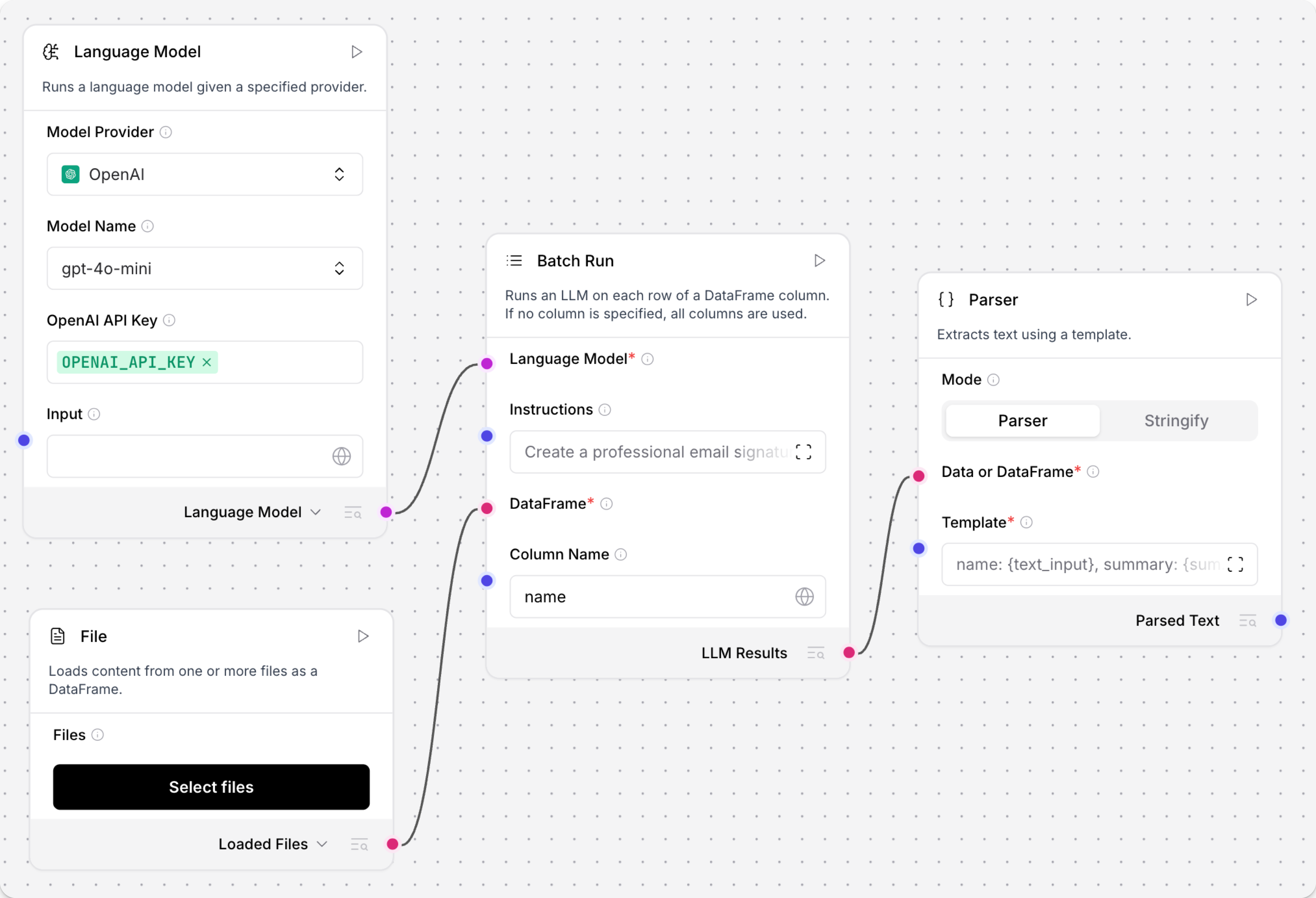
-
Connect any language model component to a Batch Run component's Language model port.
-
Connect
DataFrameoutput from another component to the Batch Run component's DataFrame input. For example, you could connect a File component with a CSV file. -
In the Batch Run component's Column Name field, enter the name of the column in the incoming
DataFramethat contains the text to process. For example, if you want to extract text from anamecolumn in a CSV file, enternamein the Column Name field. -
Connect the Batch Run component's Batch Results output to a Parser component's DataFrame input.
-
Optional: In the Batch Run component's header menu, click Controls, enable the System Message parameter, click Close, and then enter an instruction for how you want the LLM to process each cell extracted from the file. For example,
Create a business card for each name. -
In the Parser component's Template field, enter a template for processing the Batch Run component's new
DataFramecolumns (text_input,model_response, andbatch_index):For example, this template uses three columns from the resulting, post-batch
DataFrame:_10record_number: {batch_index}, name: {text_input}, summary: {model_response} -
To test the processing, click the Parser component, click Run component, and then click Inspect output to view the final
DataFrame.You can also connect a Chat Output component to the Parser component if you want to see the output in the Playground.
Batch Run parameters
Some parameters are hidden by default in the visual editor. You can modify all parameters through the Controls in the component's header menu.
| Name | Type | Description |
|---|---|---|
| model | HandleInput | Input parameter. Connect the 'Language Model' output from a language model component. Required. |
| system_message | MultilineInput | Input parameter. A multi-line system instruction for all rows in the DataFrame. |
| df | DataFrameInput | Input parameter. The DataFrame whose column is treated as text messages, as specified by 'column_name'. Required. |
| column_name | MessageTextInput | Input parameter. The name of the DataFrame column to treat as text messages. If empty, all columns are formatted in TOML. |
| output_column_name | MessageTextInput | Input parameter. Name of the column where the model's response is stored. Default=model_response. |
| enable_metadata | BoolInput | Input parameter. If True, add metadata to the output DataFrame. |
| batch_results | DataFrame | Output parameter. A DataFrame with all original columns plus the model's response column. |
Data Operations
The Data Operations component performs operations on Data objects, including extracting, filtering, and editing keys and values in the Data.
For all options, see Available data operations.
The output is a new Data object containing the modified data after running the selected operation.
Use the Data Operations component in a flow
The following example demonstrates how to use a Data Operations component in a flow using data from a webhook payload:
-
Create a flow with a Webhook component and a Data Operations component, and then connect the Webhook component's output to the Data Operations component's Data input.
All operations in the Data Operations component require at least one
Datainput from another component. If the preceding component doesn't produceDataoutput, you can use another component, such as the Type Convert component, to reformat the data before passing it to the Data Operations component. Alternatively, you could consider using a component that is designed to process the original data type, such as the Parser or DataFrame Operations components. -
In the Operations field, select the operation you want to perform on the incoming
Data. For this example, select the Select Keys operation.tipYou can select only one operation. If you need to perform multiple operations on the data, you can chain multiple Data Operations components together to execute each operation in sequence. For more complex multi-step operations, consider using a component like the Smart Function component.
-
Under Select Keys, add keys for
name,username, andemail. Click Add more to add a field for each key.For this example, assume that the webhook will receive consistent payloads that always contain
name,username, andemailkeys. The Select Keys operation extracts the value of these keys from each incoming payload. -
Optional: If you want to view the output in the Playground, connect the Data Operations component's output to a Chat Output component.
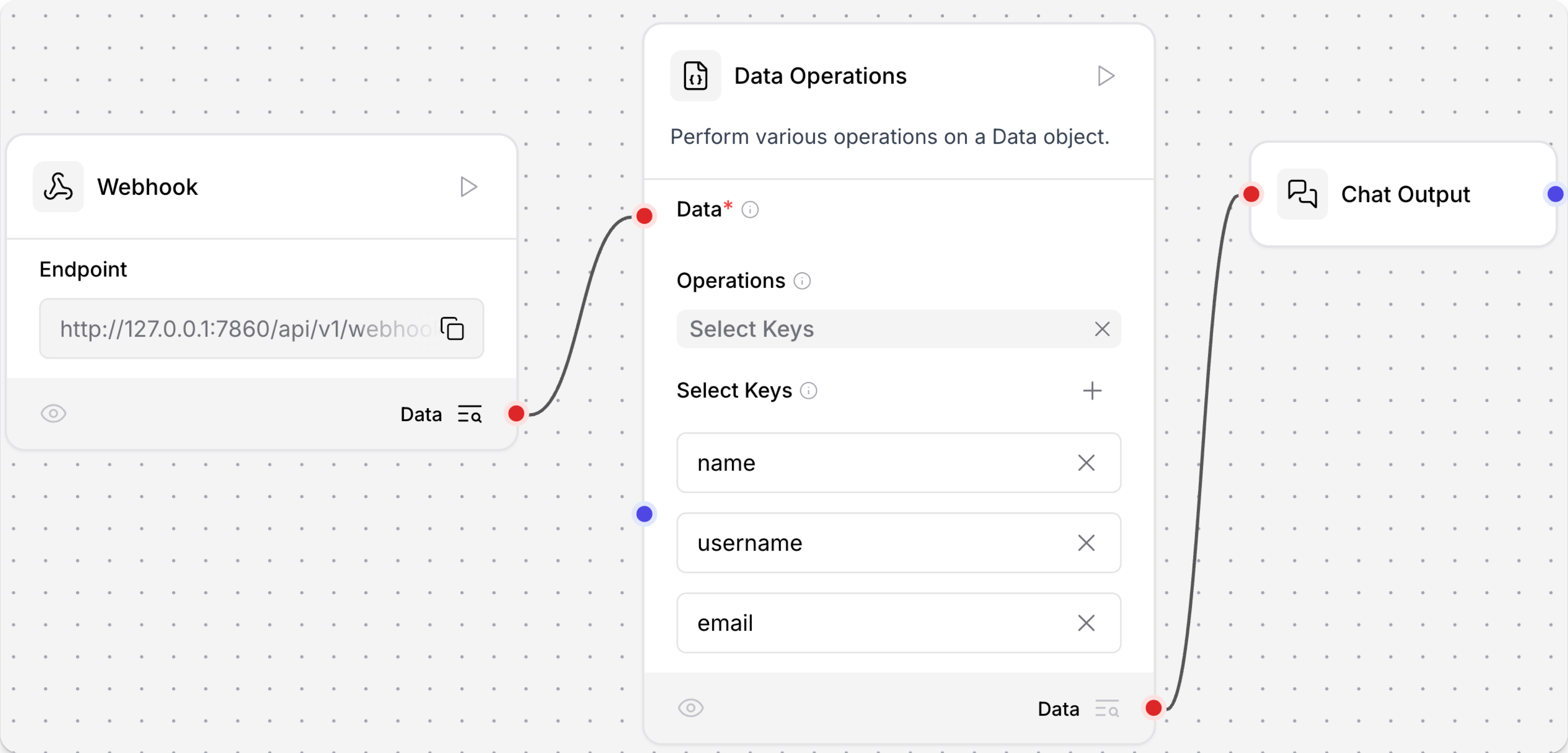
-
To test the flow, send the following request to your flow's webhook endpoint. For more information about the webhook endpoint, see Trigger flows with webhooks.
_26curl -X POST "http://$LANGFLOW_SERVER_URL/api/v1/webhook/$FLOW_ID" \_26-H "Content-Type: application/json" \_26-H "x-api-key: $LANGFLOW_API_KEY" \_26-d '{_26"id": 1,_26"name": "Leanne Graham",_26"username": "Bret",_26"email": "Sincere@april.biz",_26"address": {_26"street": "Main Street",_26"suite": "Apt. 556",_26"city": "Springfield",_26"zipcode": "92998-3874",_26"geo": {_26"lat": "-37.3159",_26"lng": "81.1496"_26}_26},_26"phone": "1-770-736-8031 x56442",_26"website": "hildegard.org",_26"company": {_26"name": "Acme-Corp",_26"catchPhrase": "Multi-layered client-server neural-net",_26"bs": "harness real-time e-markets"_26}_26}' -
To view the
Dataresulting from the Select Keys operation, do one of the following:- If you attached a Chat Output component, open the Playground to see the result as a chat message.
- Click Inspect output on the Data Operations component.
Data Operations parameters
Many parameters are conditional based on the selected Operation (operation).
| Name | Display Name | Info |
|---|---|---|
| data | Data | Input parameter. The Data object to operate on. |
| operation | Operation | Input parameter. The operation to perform on the data. See Available data operations |
| select_keys_input | Select Keys | Input parameter. A list of keys to select from the data. |
| filter_key | Filter Key | Input parameter. The key to filter by. |
| operator | Comparison Operator | Input parameter. The operator to apply for comparing values. |
| filter_values | Filter Values | Input parameter. A list of values to filter by. |
| append_update_data | Append or Update | Input parameter. The data to append or update the existing data with. |
| remove_keys_input | Remove Keys | Input parameter. A list of keys to remove from the data. |
| rename_keys_input | Rename Keys | Input parameter. A list of keys to rename in the data. |
Available data operations
Options for the operations input parameter are as follows.
All operations act on an incoming Data object.
| Name | Required Inputs | Process |
|---|---|---|
| Select Keys | select_keys_input | Selects specific keys from the data. |
| Literal Eval | None | Evaluates string values as Python literals. |
| Combine | None | Combines multiple data objects into one. |
| Filter Values | filter_key, filter_values, operator | Filters data based on key-value pair. |
| Append or Update | append_update_data | Adds or updates key-value pairs. |
| Remove Keys | remove_keys_input | Removes specified keys from the data. |
| Rename Keys | rename_keys_input | Renames keys in the data. |
DataFrame Operations
The DataFrame Operations component performs operations on DataFrame (table) rows and columns, including schema changes, record changes, sorting, and filtering.
For all options, see DataFrame Operations parameters.
The output is a new DataFrame containing the modified data after running the selected operation.
Use the DataFrame Operations component in a flow
The following steps explain how to configure a DataFrame Operations component in a flow.
You can follow along with an example or use your own flow.
The only requirement is that the preceding component must create DataFrame output that you can pass to the DataFrame Operations component.
-
Create a new flow or use an existing flow.
Example: API response extraction flow
The following example flow uses five components to extract
Datafrom an API response, transform it to aDataFrame, and then perform further processing on the tabular data using a DataFrame Operations component. The sixth component, Chat Output, is optional in this example. It only serves as a convenient way for you to view the final output in the Playground, rather than inspecting the component logs.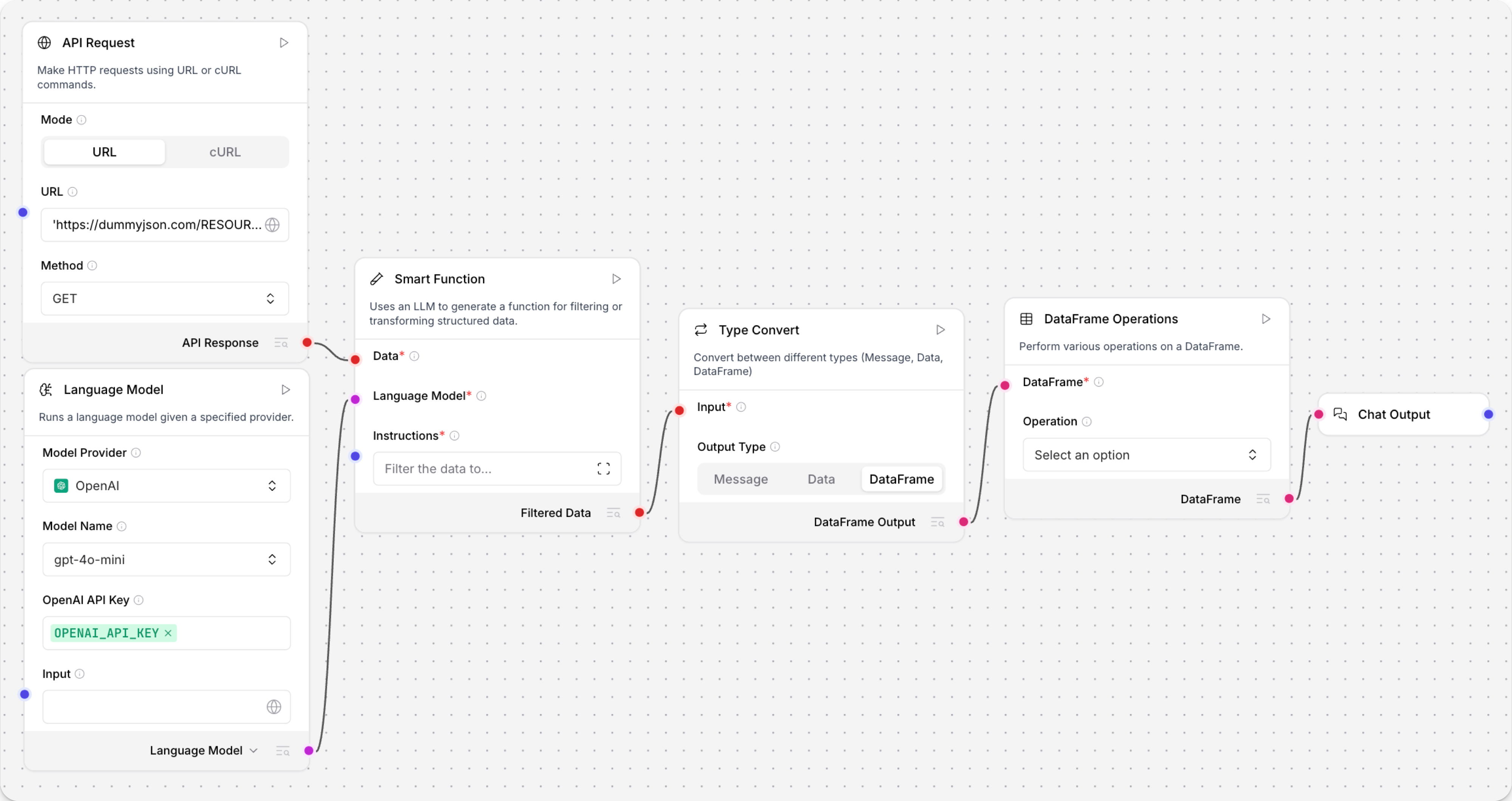
If you want to use this example to test the DataFrame Operations component, do the following:
-
Create a flow with the following components:
- API Request
- Language Model
- Smart Function
- Type Convert
-
Configure the Smart Function component and its dependencies:
- API Request: Configure the API Request component to get JSON data from an endpoint of your choice, and then connect the API Response output to the Smart Function component's Data input.
- Language Model: Select your preferred provider and model, and then enter a valid API key.
Change the output to Language Model, and then connect the
LanguageModeloutput to the Smart Function component's Language Model input. - Smart Function: In the Instructions field, enter natural language instructions to extract data from the API response.
Your instructions depend on the response content and desired outcome.
For example, if the response contains a large
resultfield, you might provide instructions likeexplode the result field out into a Data object.
-
Convert the Smart Function component's
Dataoutput toDataFrame:- Connect the Filtered Data output to the Type Convert component's Data input.
- Set the Type Convert component's Output Type to DataFrame.
Now the flow is ready for you to add the DataFrame Operations component.
-
-
Add a DataFrame Operations component to the flow, and then connect
DataFrameoutput from another component to the DataFrame input.All operations in the DataFrame Operations component require at least one
DataFrameinput from another component. If a component doesn't produceDataFrameoutput, you can use another component, such as the Type Convert component, to reformat the data before passing it to the DataFrame Operations component. Alternatively, you could consider using a component that is designed to process the original data type, such as the Parser or Data Operations components.If you are following along with the example flow, connect the Type Convert component's DataFrame Output port to the DataFrame input.
-
In the Operations field, select the operation you want to perform on the incoming
DataFrame. For example, the Filter operation filters the rows based on a specified column and value.tipYou can select only one operation. If you need to perform multiple operations on the data, you can chain multiple DataFrame Operations components together to execute each operation in sequence. For more complex multi-step operations, like dramatic schema changes or pivots, consider using an LLM-powered component, like the Structured Output or Smart Function component, as a replacement or preparation for the DataFrame Operations component.
If you're following along with the example flow, select any operation that you want to apply to the data that was extracted by the Smart Function component. To view the contents of the incoming
DataFrame, click Run component on the Type Convert component, and then Inspect output. If theDataFrameseems malformed, click Inspect output on each upstream component to determine where the error occurs, and then modify your flow's configuration as needed. For example, if the Smart Function component didn't extract the expected fields, modify your instructions or verify that the given fields are present in the API Response output. -
Configure the operation's parameters. The specific parameters depend on the selected operation. For example, if you select the Filter operation, you must define a filter condition using the Column Name, Filter Value, and Filter Operator parameters. For more information, see DataFrame Operations parameters
-
To test the flow, click Run component on the DataFrame Operations component, and then click Inspect output to view the new
DataFramecreated from the Filter operation.If you want to view the output in the Playground, connect the DataFrame Operations component's output to a Chat Output component, rerun the DataFrame Operations component, and then click Playground.
For another example, see Conditional looping.
DataFrame Operations parameters
Most DataFrame Operations parameters are conditional because they only apply to specific operations.
The only permanent parameters are DataFrame (df), which is the DataFrame input, and Operation (operation), which is the operation to perform on the DataFrame.
Once you select an operation, the conditional parameters for that operation appear on the DataFrame Operations component.
- Add Column
- Drop Column
- Filter
- Head
- Rename Column
- Replace Value
- Select Columns
- Sort
- Tail
- Drop Duplicates
The Add Column operation allows you to add a new column to the DataFrame with a constant value.
The parameters are New Column Name (new_column_name) and New Column Value (new_column_value).
The Drop Column operation allows you to remove a column from the DataFrame, specified by Column Name (column_name).
The Filter operation allows you to filter the DataFrame based on a specified condition.
The output is a DataFrame containing only the rows that matched the filter condition.
Provide the following parameters:
- Column Name (
column_name): The name of the column to filter on. - Filter Value (
filter_value): The value to filter on. - Filter Operator (
filter_operator): The operator to use for filtering, one ofequals(default),not equals,contains,starts with,ends with,greater than, orless than.
The Head operation allows you to retrieve the first n rows of the DataFrame, where n is set in Number of Rows (num_rows).
The default is 5.
The output is a DataFrame containing only the selected rows.
The Rename Column operation allows you to rename an existing column in the DataFrame.
The parameters are Column Name (column_name), which is the current name, and New Column Name (new_column_name).
The Replace Value operation allows you to replace values in a specific column of the DataFrame.
This operation replaces a target value with a new value.
All cells matching the target value are replaced with the new value in the new DataFrame output.
Provide the following parameters:
- Column Name (
column_name): The name of the column to modify. - Value to Replace (
replace_value): The value that you want to replace. - Replacement Value (
replacement_value): The new value to use.
The Select Columns operation allows you to select one or more specific columns from the DataFrame.
Provide a list of column names in Columns to Select (columns_to_select).
In the visual editor, click Add More to add multiple fields, and then enter one column name in each field.
The output is a DataFrame containing only the specified columns.
The Sort operation allows you to sort the DataFrame on a specific column in ascending or descending order.
Provide the following parameters:
- Column Name (
column_name): The name of the column to sort on. - Sort Ascending (
ascending): Whether to sort in ascending or descending order. If enabled (true), sorts in ascending order; if disabled (false), sorts in descending order. Default: Enabled (true)
The Tail operation allows you to retrieve the last n rows of the DataFrame, where n is set in Number of Rows (num_rows).
The default is 5.
The output is a DataFrame containing only the selected rows.
The Drop Duplicates operation removes rows from the DataFrame by identifying all duplicate values within a single column.
The only parameter is the Column Name (column_name).
When the flow runs, all rows with duplicate values in the given column are removed.
The output is a DataFrame containing all columns from the original DataFrame, but only rows with non-duplicate values.
LLM Router
The LLM Router component routes requests to the most appropriate LLM based on OpenRouter model specifications.
To use the component in a flow, you connect multiple language model components to the LLM Router components. One model is the judge LLM that analyzes input messages to understand the evaluation context, selects the most appropriate model from the other attached LLMs, and then routes the input to the selected model. The selected model processes the input, and then returns the generated response.
The following example flow has three language model components. One is the judge LLM, and the other two are in the LLM pool for request routing. The input and output components create a seamless chat interaction where you send a message and receive a response without any user awareness of the underlying routing.
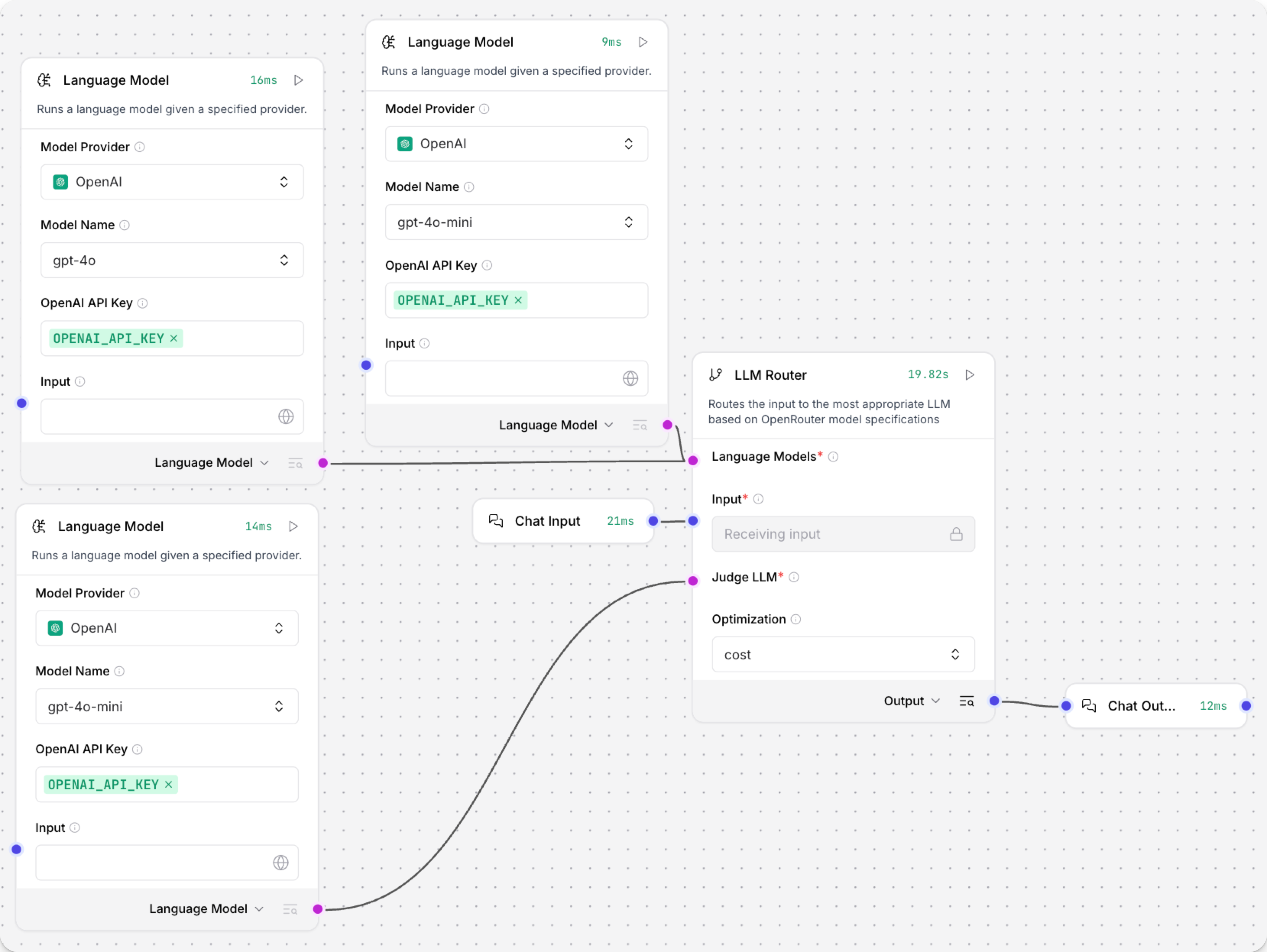
LLM Router parameters
Some parameters are hidden by default in the visual editor. You can modify all parameters through the Controls in the component's header menu.
| Name | Display Name | Info |
|---|---|---|
models | Language Models | Input parameter. Connect LanguageModel output from multiple language model components to create a pool of models. The judge_llm selects models from this pool when routing requests. The first model you connect is the default model if there is a problem with model selection or routing. |
input_value | Input | Input parameter. The incoming query to be routed to the model selected by the judge LLM. |
judge_llm | Judge LLM | Input parameter. Connect LanguageModel output from one Language Model component to serve as the judge LLM for request routing. |
optimization | Optimization | Input parameter. Set a preferred characteristic for model selection by the judge LLM. The options are quality (highest response quality), speed (fastest response time), cost (most cost-effective model), or balanced (equal weight for quality, speed, and cost). Default: balanced |
use_openrouter_specs | Use OpenRouter Specs | Input parameter. Whether to fetch model specifications from the OpenRouter API. |
If false, only the model name is provided to the judge LLM. Default: Enabled (true) | ||
timeout | API Timeout | Input parameter. Set a timeout duration in seconds for API requests made by the router. Default: 10 |
fallback_to_first | Fallback to First Model | Input parameter. Whether to use the first LLM in models as a backup if routing fails to reach the selected model. Default: Enabled (true) |
LLM Router outputs
The LLM Router component provides three output options. You can set the desired output type near the component's output port.
-
Output: A
Messagecontaining the response to the original query as generated by the selected LLM. Use this output for regular chat interactions. -
Selected Model Info: A
Dataobject containing information about the selected model, such as its name and version. -
Routing Decision: A
Messagecontaining the judge model's reasoning for selecting a particular model, including input query length and number of models considered. For example:_10Model Selection Decision:_10- Selected Model Index: 0_10- Selected Langflow Model Name: gpt-4o-mini_10- Selected API Model ID (if resolved): openai/gpt-4o-mini_10- Optimization Preference: cost_10- Input Query Length: 27 characters (~5 tokens)_10- Number of Models Considered: 2_10- Specifications Source: OpenRouter APIThis is useful for debugging if you feel the judge model isn't selecting the best model.
Parser
The Parser component extracts text from structured data (DataFrame or Data) using a template or direct stringification.
The output is a Message containing the parsed text.
This is a versatile component for data extraction and manipulation in your flows. For examples of Parser components in flows, see the following:
- Batch Run component example
- Structured Output component example
- Financial Report Parser template
- Trigger flows with webhooks
- Create a vector RAG chatbot
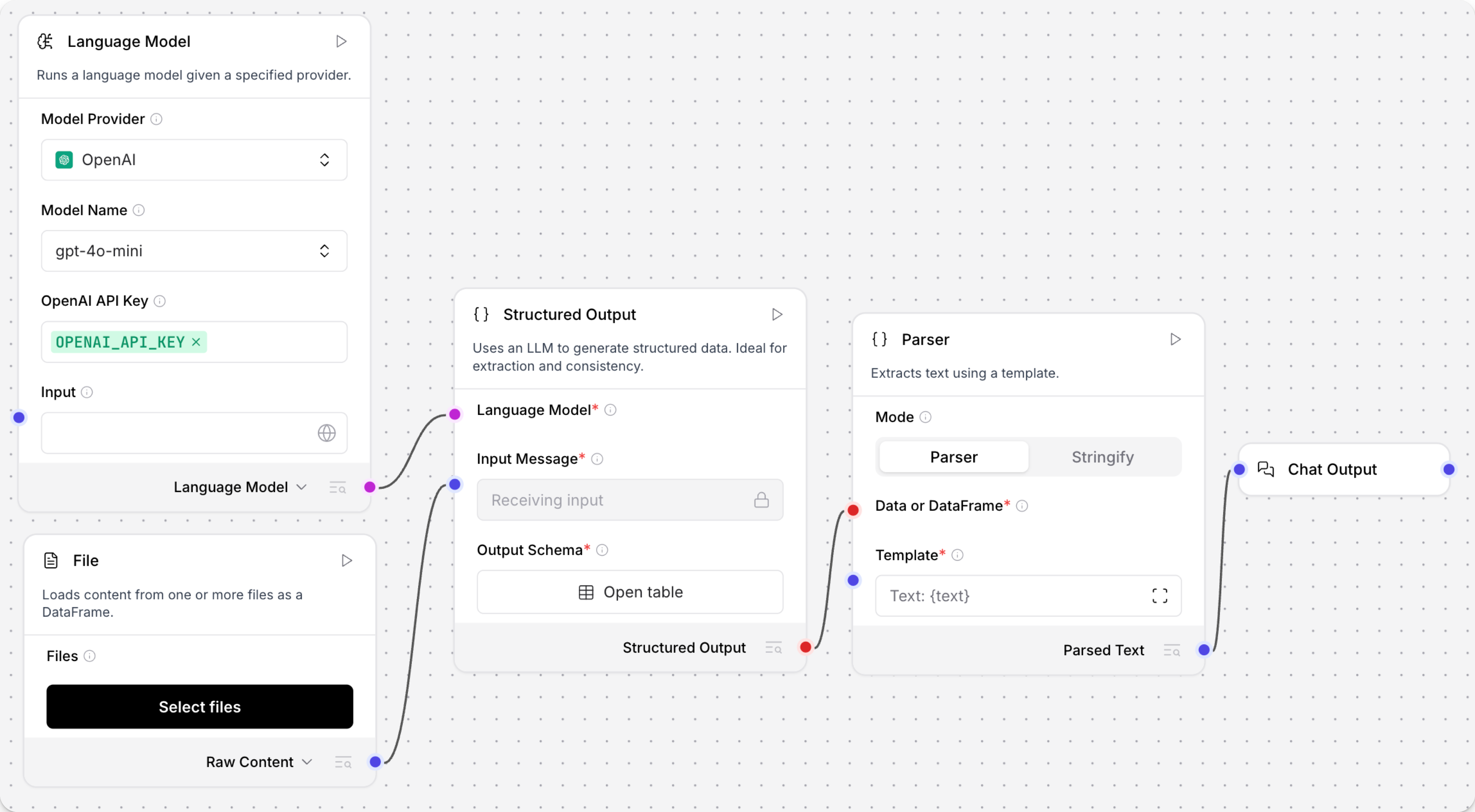
Parsing modes
The Parser component has two modes: Parser and Stringify.
- Parser (template) mode
- Stringify mode
In Parser mode, you create a template for text output that can include literal strings and variables for extracted keys.
Use curly braces to define variables anywhere in the template.
Variables must match keys in the DataFrame or Data input, such as column names.
For example, {name} extracts the value of a name key.
For more information about the content and structure of DataFrame and Data objects, see Langflow data types.
If your template includes literal text and variables, you can use double curly braces to escape literal curly braces in the template and prevent interpretation of that text as a variable.
For example: This is a template with {{literal text in curly braces}} and a {variable}.
When the flow runs, the Parser component iterates over the input, producing a Message for each parsed item.
For example, parsing a DataFrame creates a Message for each row, populated with the unique values from that row.
Employee summary template
This example template extracts employee data into a natural language summary about an employee's hire date and current role:
_10{employee_first_name} {employee_last_name} was hired on {start_date}._10Their current position is {job_title} ({grade}).
The resulting Message output replaces the variables with the corresponding extracted values.
For example:
_10Renlo Kai was hired on 11-July-2017._10Their current position is Software Engineer (Principal).
Employee profile template
This example template uses Markdown syntax and extracted employee data to create an employee profile:
_10# Employee Profile_10## Personal Information_10- **Name:** {name}_10- **ID:** {id}_10- **Email:** {email}
When the flow runs, the Parser component iterates over each row of the DataFrame, populating the template's variables with the appropriate extracted values.
The resulting text for each row is output as a Message.
The following parameters are available in Parser mode.
Some parameters are hidden by default in the visual editor. You can modify all parameters through the Controls in the component's header menu.
| Name | Display Name | Info |
|---|---|---|
| input_data | Data or DataFrame | Input parameter. The Data or DataFrame input to parse. |
| pattern | Template | Input parameter. The formatting template using plaintext and variables for keys ({KEY_NAME}). See the preceding examples for more information. |
| sep | Separator | Input parameter. A string defining the separator for rows or lines. Default: \n (new line). |
| clean_data | Clean Data | Whether to remove empty rows and lines in each cell or key of the DataFrame or Data input. Default: Enabled (true) |
Use Stringify mode to convert the entire input directly to text. This mode doesn't support templates or key selection.
The following parameters are available in Stringify mode.
Some parameters are hidden by default in the visual editor. You can modify all parameters through the Controls in the component's header menu.
| Name | Display Name | Info |
|---|---|---|
| input_data | Data or DataFrame | Input parameter. The Data or DataFrame input to parse. |
| sep | Separator | Input parameter. A string defining the separator for rows or lines. Default: \n (new line). |
| clean_data | Clean Data | Whether to remove empty rows and lines in each cell or key of the DataFrame or Data input. Default: Enabled (true) |
Test and troubleshoot parsed text
To test the Parser component, click Run component, and then click Inspect output to see the Message output with the parsed text.
You can also connect a Chat Output component if you want to view the output in the Playground.
If the Message output from the Parser component has empty or unexpected values, there might be a mapping error between the input and the parsing mode, the input has empty values, or the input isn't suitable for plaintext extraction.
For example, assume you use the following template to parse a DataFrame:
_10{employee_first_name} {employee_last_name} is a {job_title} ({grade}).
The following Message could result from parsing a row where employee_first_name was empty and grade was null:
_10 Smith is a Software Engineer (null).
To troubleshoot missing or unexpected values, you can do the following:
-
Make sure the variables in your template map to keys in the incoming
DataorDataFrame. To see the data being passed directly to the Parser component, click Inspect output on the component that is sending data to the Parser component. -
Check the source data for missing or incorrect values. There are several ways you can address these inconsistencies:
- Rectify the source data directly.
- Use other components to amend or filter anomalies before passing the data to the Parser component. There are many components you can use for this depending on your goal, such as the Data Operations, Structured Output, and Smart Function components.
- Enable the Parser component's Clean Data parameter to skip empty rows or lines.
Python Interpreter
This component allows you to execute Python code with imported packages.
The Python Interpreter component can only import packages that are already installed in your Langflow environment.
If you encounter an ImportError when trying to use a package, you need to install it first.
To install custom packages, see Install custom dependencies.
Use the Python Interpreter in a flow
- To use this component in a flow, in the Global Imports field, add the packages you want to import as a comma-separated list, such as
math,pandas. At least one import is required. - In the Python Code field, enter the Python code you want to execute. Use
print()to see the output. - Optional: Enable Tool Mode, and then connect the Python Interpreter component to an Agent component as a tool.
For example, connect a Python Interpreter component and a Calculator component as tools for an Agent component, and then test how it chooses different tools to solve math problems.
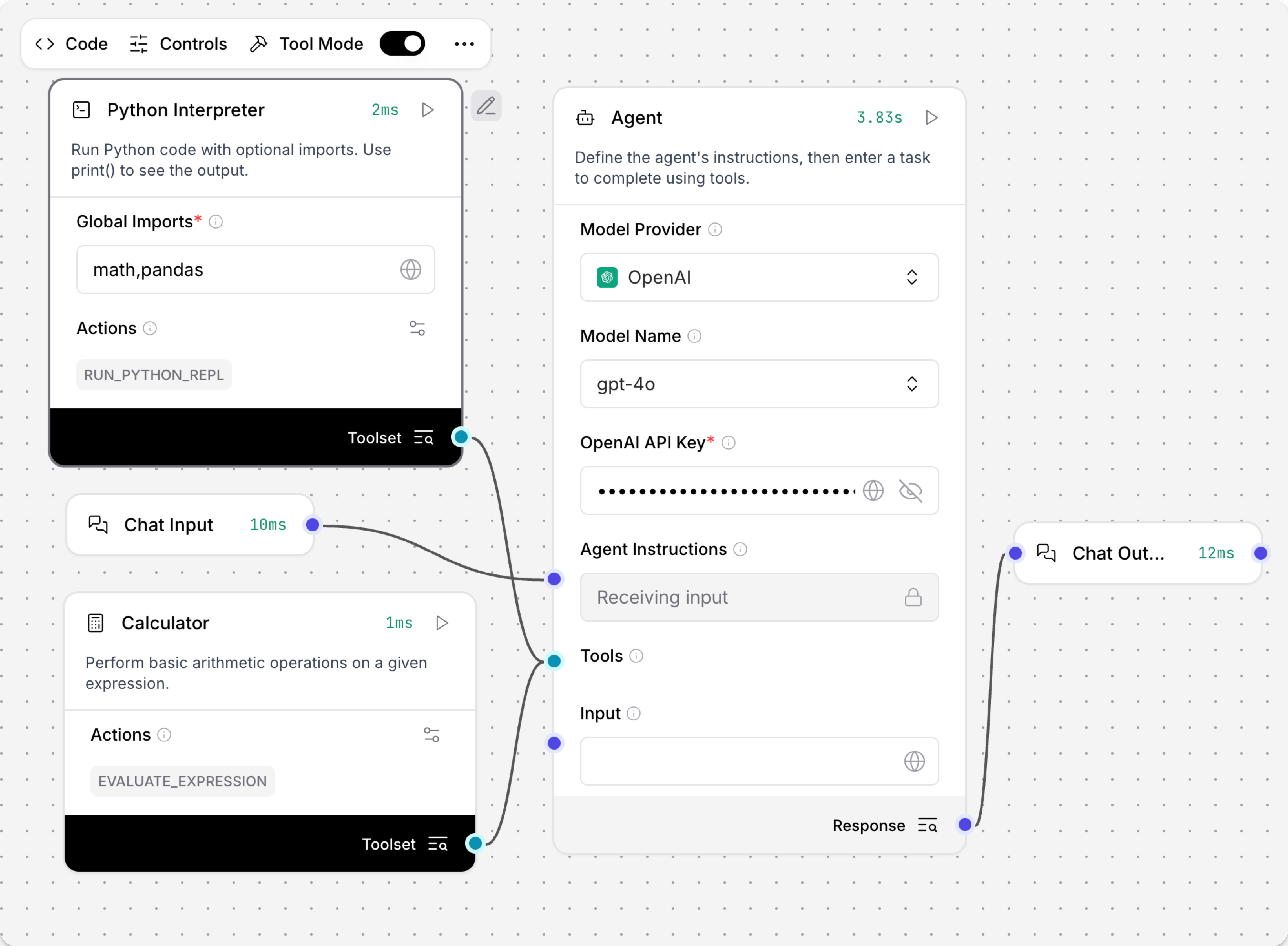
- Ask the agent an easier math question.
The Calculator tool can add, subtract, multiple, divide, or perform exponentiation.
The agent executes the
evaluate_expressiontool to correctly answer the question.
Result:
_10Executed evaluate_expression_10Input:_10{_10 "expression": "2+5"_10}_10Output:_10{_10 "result": "7"_10}
- Give the agent complete Python code.
This example creates a Pandas DataFrame table with the imported
pandaspackages, and returns the square root of the mean squares.
_12import pandas as pd_12import math_12_12# Create a simple DataFrame_12df = pd.DataFrame({_12 'numbers': [1, 2, 3, 4, 5],_12 'squares': [x**2 for x in range(1, 6)]_12})_12_12# Calculate the square root of the mean_12result = math.sqrt(df['squares'].mean())_12print(f"Square root of mean squares: {result}")
The agent correctly chooses the run_python_repl tool to solve the problem.
Result:
_12Executed run_python_repl_12_12Input:_12_12{_12 "python_code": "import pandas as pd\nimport math\n\n# Create a simple DataFrame\ndf = pd.DataFrame({\n 'numbers': [1, 2, 3, 4, 5],\n 'squares': [x**2 for x in range(1, 6)]\n})\n\n# Calculate the square root of the mean\nresult = math.sqrt(df['squares'].mean())\nprint(f\"Square root of mean squares: {result}\")"_12}_12Output:_12_12{_12 "result": "Square root of mean squares: 3.3166247903554"_12}
If you don't include the package imports in the chat, the agent can still create the table using pd.DataFrame, because the pandas package is imported globally by the Python Interpreter component in the Global Imports field.
Python Interpreter parameters
| Name | Type | Description |
|---|---|---|
| global_imports | String | Input parameter. A comma-separated list of modules to import globally, such as math,pandas,numpy. |
| python_code | Code | Input parameter. The Python code to execute. Only modules specified in Global Imports can be used. |
| results | Data | Output parameter. The output of the executed Python code, including any printed results or errors. |
Save File
The Save File component creates a file containing data produced by another component. Several file formats are supported, and you can store files in Langflow storage or the local file system.
To configure the Save File component and use it in a flow, do the following:
-
Connect
DataFrame,Data, orMessageoutput from another component to the Save File component's Input port.You can connect the same output to multiple Save File components if you want to create multiple files, save the data in different file formats, or save files to multiple locations.
-
In File Name, enter a file name and an optional path.
The File Name parameter controls where the file is saved. It can contain a file name or an entire file path:
-
Default location: If you only provide a file name, then the file is stored in the Langflow data directory. For example,
~/Library/Caches/langflow/dataon macOS. -
Subdirectory: To store files in subdirectories, add the path to the File Name parameter. If a given subdirectory doesn't already exist, Langflow automatically creates it. For example,
files/my_filecreatesmy_filein/data/files, and it creates thefilessubdirectory if it doesn't already exist. -
Absolute or relative path: To store files elsewhere in your environment or local file storage, provide the absolute or relative path to the desired location. For example,
~/Desktop/my_filesavesmy_fileto the desktop.
Don't include an extension in the file name. If you do, the extension is treated as part of the file name; it has no impact on the File Format parameter.
-
-
In the component's header menu, click Controls, select the desired file format, and then click Close.
The available File Format options depend on the input data type:
-
DataFramecan be saved to CSV (default), Excel (requiresopenpyxlcustom dependency), JSON (fallback default), or Markdown. -
Datacan be saved to CSV, Excel (requiresopenpyxlcustom dependency), JSON (default), or Markdown. -
Messagecan be saved to TXT, JSON (default), or Markdown.
Overwrites allowedIf you have multiple Save File components, in one or more flows, with the same file name, path, and extension, the file contains the data from the most recent run only. Langflow doesn't block overwrites if a matching file already exists. To avoid unintended overwrites, use unique file names and paths.
-
-
To test the Save File component, click Run component, and then click Inspect output to get the filepath where the file was saved.
The component's literal output is a
Messagecontaining the original data type, the file name and extension, and the absolute filepath to the file based on the File Name parameter. For example:_10DataFrame saved successfully as 'my_file.csv' at /Users/user.name/Library/Caches/langflow/data/my_file.csvIf the File Name contains a subdirectory or other non-default path, this is reflected in the
Messageoutput. For example, a CSV file with the file name~/Desktop/my_filecould produce the following output:_10DataFrame saved successfully as '/Users/user.name/Desktop/my_file.csv' at /Users/user.name/Desktop/my_file.csv -
Optional: If you want to use the saved file in a flow, you must use an API call or another component to retrieve the file from the given filepath.
Smart Function
In Langflow version 1.5, this component was renamed from Lambda Filter to Smart Function.
The Smart Function component uses an LLM to generate a Lambda function to filter or transform structured data based on natural language instructions.
You must connect this component to a language model component, which is used to generate a function based on the natural language instructions you provide in the Instructions parameter.
The LLM runs the function against the data input, and then outputs the results as Data.
Provide brief, clear instructions, focusing on the desired outcome or specific actions, such as Filter the data to only include items where the 'status' is 'active'.
One sentence or less is preferred because end punctuation, like periods, can cause errors or unexpected behavior.
If you need to provide more details instructions that aren't directly relevant to the Lambda function, you can input them in the Language Model component's Input field or through a Prompt Template component.
The following example uses the API Request endpoint to pass JSON data from the https://jsonplaceholder.typicode.com/users endpoint to the Smart Function component.
Then, the Smart Function component passes the data and the instruction extract emails to the attached Language Model component.
From there, the LLM generates a filter function that extracts email addresses from the JSON data, returning the filtered data as chat output.
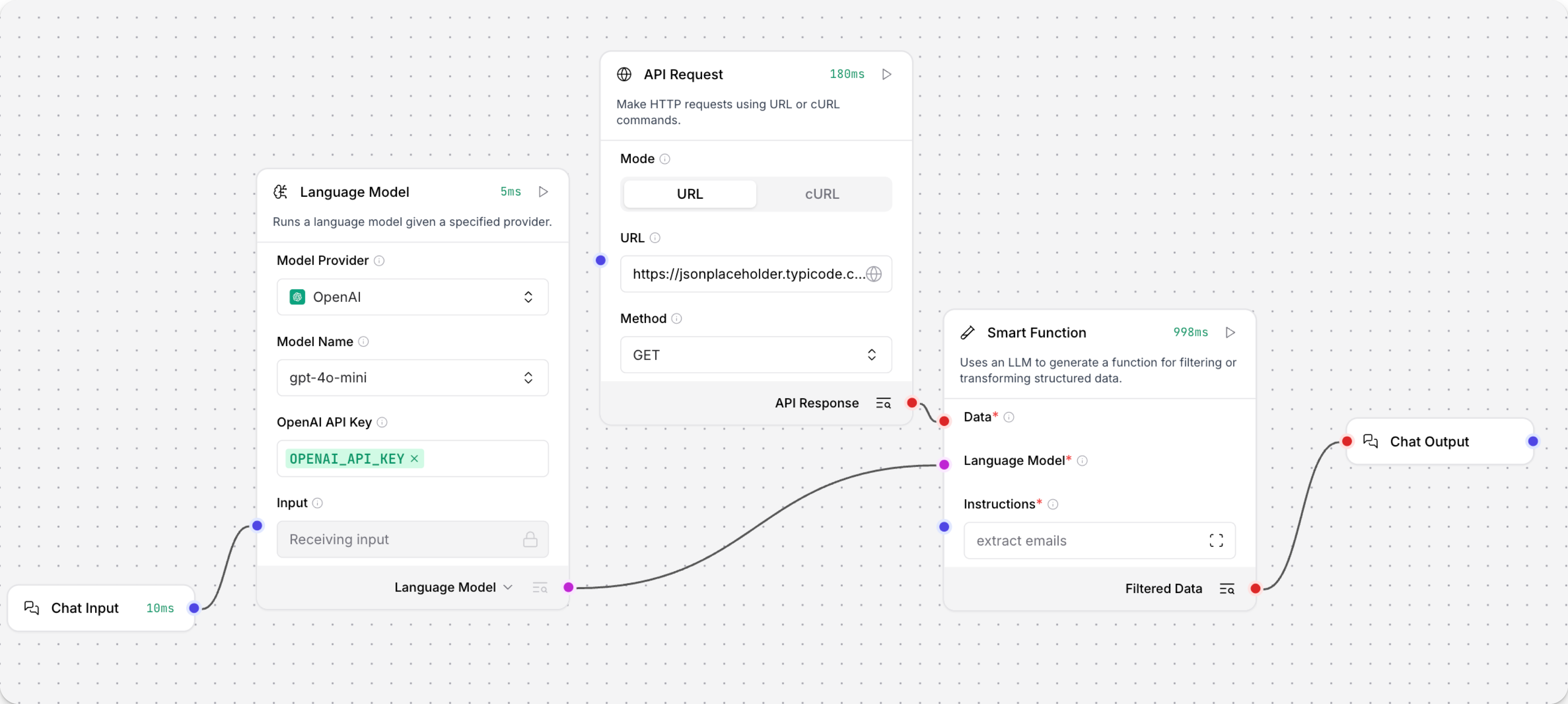
Smart Function parameters
Some parameters are hidden by default in the visual editor. You can modify all parameters through the Controls in the component's header menu.
| Name | Display Name | Info |
|---|---|---|
| data | Data | Input parameter. The structured data to filter or transform using a Lambda function. |
| llm | Language Model | Input parameter. Connect LanguageModel output from a Language Model component. |
| filter_instruction | Instructions | Input parameter. The natural language instructions for how to filter or transform the data. The LLM uses these instructions to create a Lambda function. |
| sample_size | Sample Size | Input parameter. For large datasets, the number of characters to sample from the dataset head and tail. Only applied if the dataset meets or exceeds max_size. Default: 1000. |
| max_size | Max Size | Input parameter. The number of characters for the dataset to be considered large, which triggers sampling by the sample_size value. Default: 30000. |
Split Text
The Split Text component splits data into chunks based on parameters like chunk size and separator. It is often used to chunk data to be tokenized and embedded into vector databases. For examples, see Use embedding model components in a flow and Create a Vector RAG chatbot.
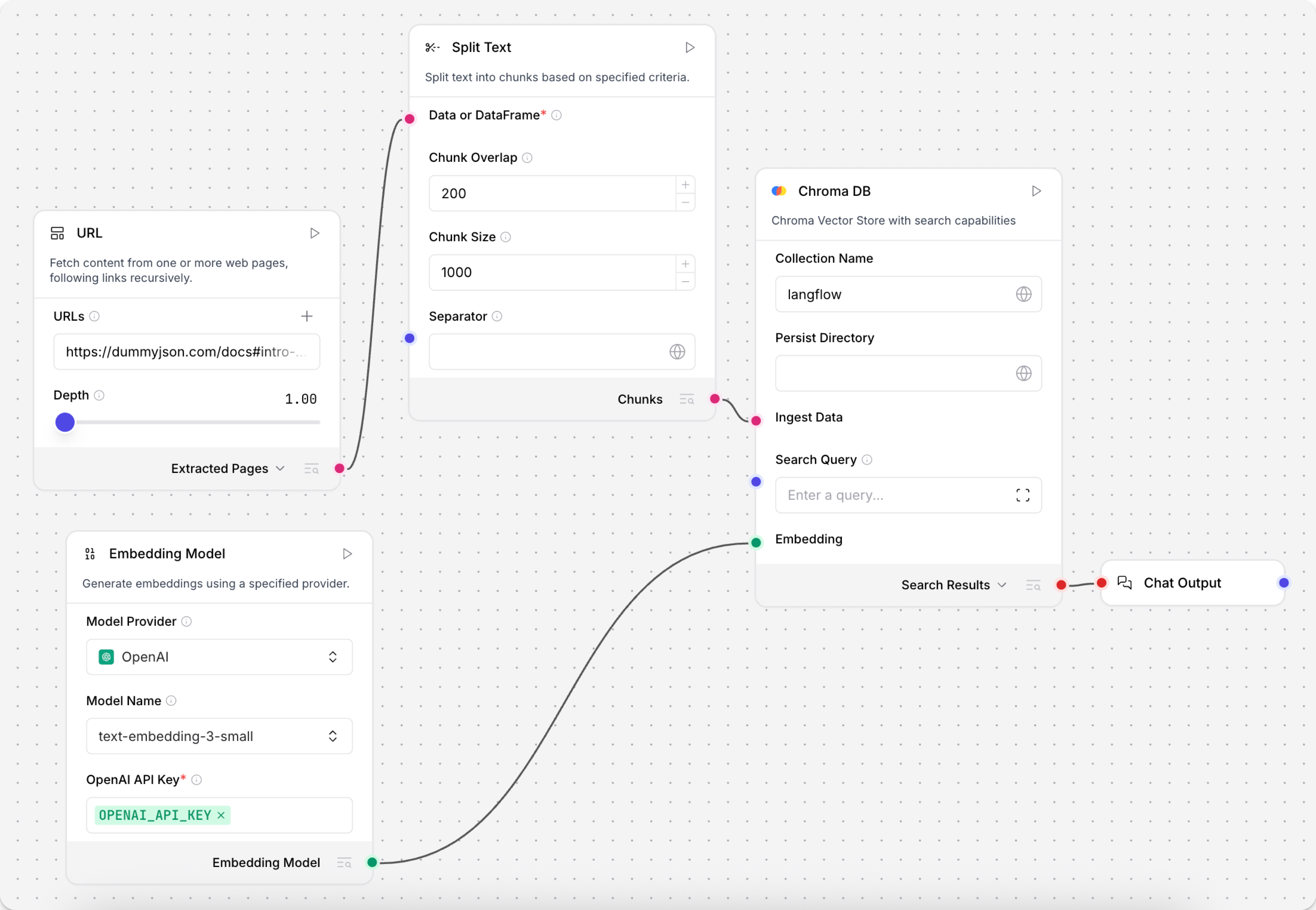
The component accepts Message, Data, or DataFrame, and then outputs either Chunks or DataFrame.
The Chunks output returns a list of Data objects containing individual text chunks.
The DataFrame output returns the list of chunks as a structured DataFrame with additional text and metadata columns.
Split Text parameters
The Split Text component's parameters control how the text is split into chunks, specifically the chunk_size, chunk_overlap, and separator parameters.
To test the chunking behavior, add a Text Input or File component with some sample data to chunk, click Run component on the Split Text component, and then click Inspect output to view the list of chunks and their metadata. The text column contains the actual text chunks created from your chunking settings. If the chunks aren't split as you expect, adjust the parameters, rerun the component, and then inspect the new output.
Some parameters are hidden by default in the visual editor. You can modify all parameters through the Controls in the component's header menu.
| Name | Display Name | Info |
|---|---|---|
| data_inputs | Input | Input parameter. The data to split. Input must be in Message, Data, or DataFrame format. |
| chunk_overlap | Chunk Overlap | Input parameter. The number of characters to overlap between chunks. This helps maintain context across chunks. When a separator is encountered, the overlap is applied at the point of the separator so that the subsequent chunk contains the last n characters of the preceding chunk. Default: 200. |
| chunk_size | Chunk Size | Input parameter. The target length for each chunk after splitting. The data is first split by separator, and then chunks smaller than the chunk_size are merged up to this limit. However, if the initial separator split produces any chunks larger than the chunk_size, those chunks are neither further subdivided nor combined with any smaller chunks; these chunks will be output as-is even though they exceed the chunk_size. Default: 1000. See Tokenization errors due to chunk size for important considerations. |
| separator | Separator | Input parameter. A string defining a character to split on, such as \n to split on new line characters, \n\n to split at paragraph breaks, or }, to split at the end of JSON objects. You can directly provide the separator string, or pass a separator string from another component as Message input. |
| text_key | Text Key | Input parameter. The key to use for the text column that is extracted from the input and then split. Default: text. |
| keep_separator | Keep Separator | Input parameter. Select how to handle separators in output chunks. If False, separators are omitted from output chunks. Options include False (remove separators), True (keep separators in chunks without preference for placement), Start (place separators at the beginning of chunks), or End (place separators at the end of chunks). Default: False. |
Tokenization errors due to chunk size
When using Split Text with embedding models (especially NVIDIA models like nvidia/nv-embed-v1), you may need to use smaller chunk sizes (500 or less) even though the model supports larger token limits.
The Split Text component doesn't always enforce the exact chunk size you set, and individual chunks may exceed your specified limit.
If you encounter tokenization errors, modify your text splitting strategy by reducing the chunk size, changing the overlap length, or using a more common separator.
Then, test your configuration by running the flow and inspecting the component's output.
Other text splitters
See LangChain text splitter components.
Structured Output
The Structured Output component uses an LLM to transform any input into structured data (Data or DataFrame) using natural language formatting instructions and an output schema definition.
For example, you can extract specific details from documents, like email messages or scientific papers.
Use the Structured Output component in a flow
To use the Structured Output component in a flow, do the following:
-
Provide an Input Message, which is the source material from which you want to extract structured data. This can come from practically any component, but it is typically a Chat Input, File, or other component that provides some unstructured or semi-structured input.
tipNot all source material has to become structured output. The power of the Structured Output component is that you can specify the information you want to extract, even if that data isn't explicitly labeled or an exact keyword match. Then, the LLM can use your instructions to analyze the source material, extract the relevant data, and format it according to your specifications. Any irrelevant source material isn't included in the structured output.
-
Define Format Instructions and an Output Schema to specify the data to extract from the source material and how to structure it in the final
DataorDataFrameoutput.The instructions are a prompt that tell the LLM what data to extract, how to format it, how to handle exceptions, and any other instructions relevant to preparing the structured data.
The schema is a table that defines the fields (keys) and data types to organize the data extracted by the LLM into a structured
DataorDataFrameobject. For more information, see Output Schema options -
Attach a language model component that is set to emit
LanguageModeloutput.The LLM uses the Input Message and Format Instructions from the Structured Output component to extract specific pieces of data from the input text. The output schema is applied to the model's response to produce the final
DataorDataFramestructured object. -
Optional: Typically, the structured output is passed to downstream components that use the extracted data for other processes, such as the Parser or Data Operations components.
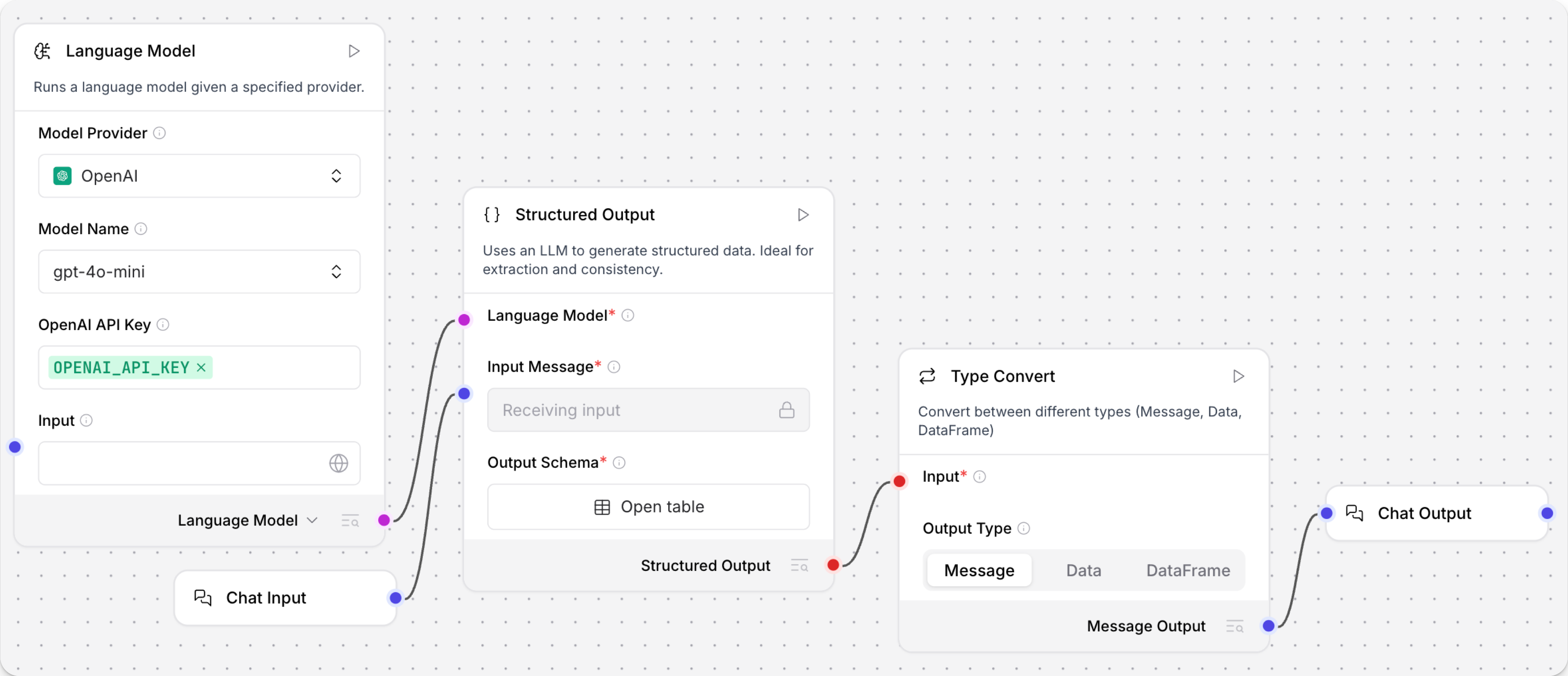
Structured Output example: Financial Report Parser template
The Financial Report Parser template provides an example of how the Structured Output component can be used to extract structured data from unstructured text.
The template's Structured Output component has the following configuration:
-
The Input Message comes from a Chat Input component that is preloaded with quotes from sample financial reports
-
The Format Instructions are as follows:
_10You are an AI that extracts structured JSON objects from unstructured text._10Use a predefined schema with expected types (str, int, float, bool, dict)._10Extract ALL relevant instances that match the schema - if multiple patterns exist, capture them all._10Fill missing or ambiguous values with defaults: null for missing values._10Remove exact duplicates but keep variations that have different field values._10Always return valid JSON in the expected format, never throw errors._10If multiple objects can be extracted, return them all in the structured format. -
The Output Schema includes keys for
EBITDA,NET_INCOME, andGROSS_PROFIT.
The structured Data object is passed to a Parser component that produces a text string by mapping the schema keys to variables in the parsing template:
_10EBITDA: {EBITDA} , Net Income: {NET_INCOME} , GROSS_PROFIT: {GROSS_PROFIT}
When printed to the Playground, the resulting Message replaces the variables with the actual values extracted by the Structured Output component. For example:
_10EBITDA: 900 million , Net Income: 500 million , GROSS_PROFIT: 1.2 billion
Structured Output parameters
Some parameters are hidden by default in the visual editor. You can modify all parameters through the Controls in the component's header menu.
| Name | Type | Description |
|---|---|---|
Language Model (llm) | LanguageModel | Input parameter. The LanguageModel output from a Language Model component that defines the LLM to use to analyze, extract, and prepare the structured output. |
Input Message (input_value) | String | Input parameter. The input message containing source material for extraction. |
Format Instructions (system_prompt) | String | Input parameter. The instructions to the language model for extracting and formatting the output. |
Schema Name (schema_name) | String | Input parameter. An optional title for the Output Schema. |
Output Schema (output_schema) | Table | Input parameter. A table describing the schema of the desired structured output, ultimately determining the content of the Data or DataFrame output. See Output Schema options. |
Structured Output (structured_output) | Data or DataFrame | Output parameter. The final structured output produced by the component. Near the component's output port, you can select the output data type as either Structured Output Data or Structured Output DataFrame. The specific content and structure of the output depends on the input parameters. |
Output Schema options
After the LLM extracts the relevant data from the Input Message and Format Instructions, the data is organized according to the Output Schema.
The schema is a table that defines the fields (keys) and data types for the final Data or DataFrame output from the Structured Output component.
The default schema is a single field string.
To add a key to the schema, click Add a new row, and then edit each column to define the schema:
-
Name: The name of the output field. Typically a specific key for which you want to extract a value.
You can reference these keys as variables in downstream components, such as a Parser component's template. For example, the schema key
NET_INCOMEcould be referenced by the variable{NET_INCOME}. -
Description: An optional metadata description of the field's contents and purpose.
-
Type: The data type of the value stored in the field. Supported types are
str(default),int,float,bool, anddict. -
As List: Enable this setting if you want the field to contain a list of values rather than a single value.
For simple schemas, you might only extract a few string or int fields.
For more complex schemas with lists and dictionaries, it might help to refer to the Data and DataFrame structures and attributes, as described in Langflow data types.
You can also emit a rough Data or DataFrame, and then use downstream components for further refinement, such as a Data Operations component.
Type Convert
The Type Convert component converts data from one type to another.
It supports Data, DataFrame, and Message data types.
- Data
- DataFrame
- Message
A Data object is a structured object that contains a primary text key and other key-value pairs:
_10"data": {_10 "text": "User Profile",_10 "name": "Charlie Lastname",_10 "age": 28,_10 "email": "charlie.lastname@example.com"_10},
The larger context associated with a component's data dictionary also identifies which key is the primary text_key, and it can provide an optional default value if the primary key isn't specified.
For example:
_10{_10 "text_key": "text",_10 "data": {_10 "text": "User Profile",_10 "name": "Charlie Lastname",_10 "age": 28,_10 "email": "charlie.lastname@example.com"_10 },_10 "default_value": ""_10}
A DataFrame is an array that represents a tabular data structure with rows and columns.
It consists of a list (array) of dictionary objects, where each dictionary represents a row.
Each key in the dictionaries corresponds to a column name.
For example, the following DataFrame contains two rows with columns for name, age, and email:
_12[_12 {_12 "name": "Charlie Lastname",_12 "age": 28,_12 "email": "charlie.lastname@example.com"_12 },_12 {_12 "name": "Bobby Othername",_12 "age": 25,_12 "email": "bobby.othername@example.com"_12 }_12]
A Message is primarily for passing a text string, such as"Name: Charlie Lastname, Age: 28, Email: charlie.lastname@example.com".
However, the entire Message object can include metadata about the message, particularly when used as chat input or output.
For more information, see Langflow data types.
Use the Type Convert component in a flow
The Type Convert component is typically used to transform data into a format required by a downstream component.
For example, if a component outputs a Message, but the following component requires Data, then you can use the Type Convert component to reformat the Message as Data before passing it to the downstream component.
The following example uses the Type Convert component to convert the DataFrame output from a Web Search component into Message data that is passed as text input for an LLM:
-
Create a flow based on the Basic prompting template.
-
Add a Web Search component to the flow, and then enter a search query, such as
environmental news. -
In the Prompt Template component, replace the contents of the Template field with the following text:
_10Answer the user's question using the {context}The curly braces define a prompt variable that becomes an input field on the Prompt Template component. In this example, you will use the context field to pass the search results into the template, as explained in the next steps.
-
Add a Type Convert component to the flow, and then set the Output Type to Message.
Because the Web Search component's
DataFrameoutput is incompatible with the context variable'sMessageinput, you must use the Type Convert component to change theDataFrameto aMessagein order to pass the search results to the Prompt Template component. -
Connect the additional components to the rest of the flow:
- Connect the Web Search component's output to the Type Convert component's input.
- Connect the Type Convert component's output to the Prompt Template component's context input.
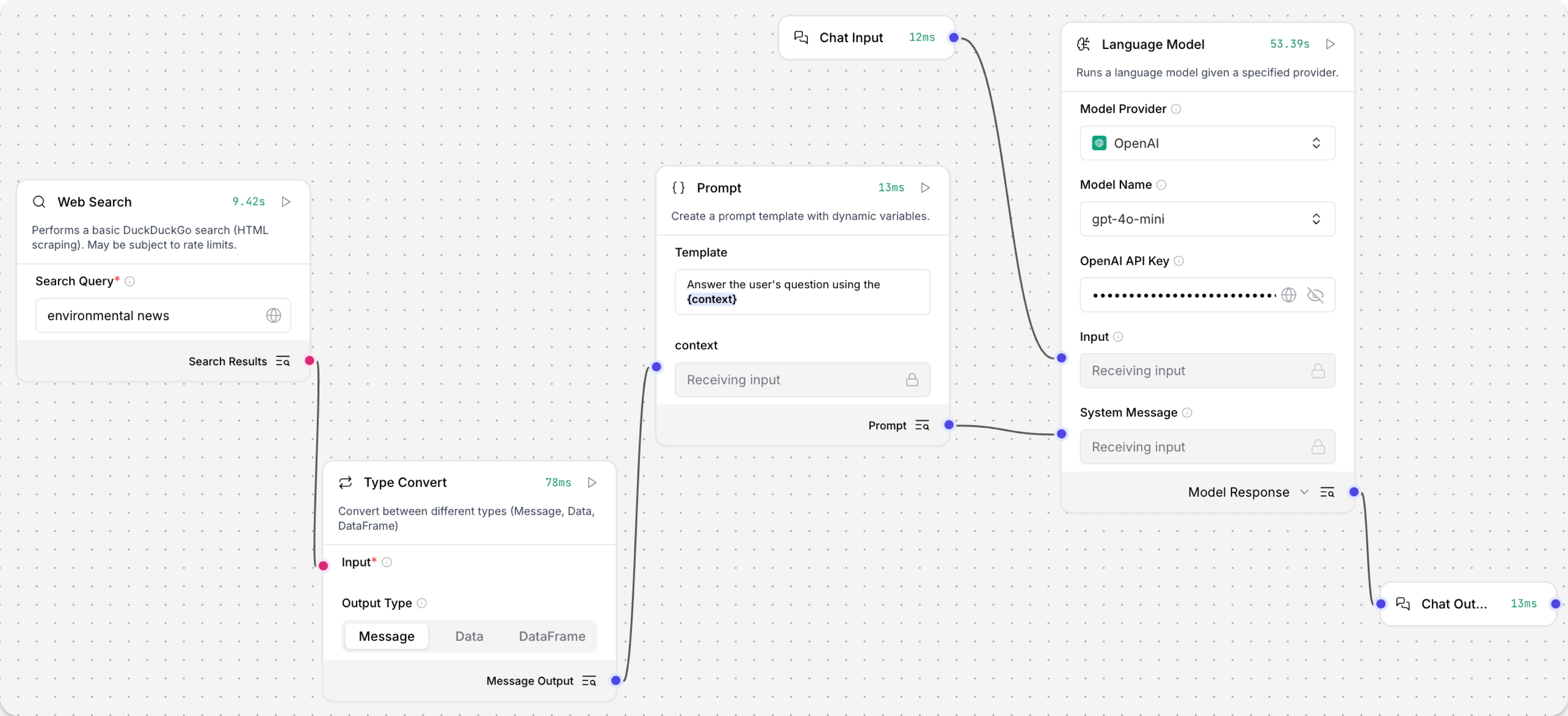
-
In the Language Model component, add your OpenAI API key.
If you want to use a different provider or model, edit the Model Provider, Model Name, and API Key fields accordingly.
-
Click Playground, and then ask something relevant to your search query, such as
latest newsorwhat's the latest research on the environment?.Result
The LLM uses the search results context, your chat message, and it's built-in training data to respond to your question. For example:
_10Here are some of the latest news articles related to the environment:_10Ozone Pollution and Global Warming: A recent study highlights that ozone pollution is a significant global environmental concern, threatening human health and crop production while exacerbating global warming. Read more_10...
Type Convert parameters
| Name | Display Name | Info |
|---|---|---|
| input_data | Input Data | Input parameter. The data to convert. Accepts Data, DataFrame, or Message input. |
| output_type | Output Type | Input parameter. The desired output type, as one of Data, DataFrame or Message. |
| output | Output | Output parameter. The converted data in the specified format. The output port changes depending on the selected Output Type. |
Legacy Processing components
Legacy components are longer supported and can be removed in a future release. You can continue to use them in existing flows, but it is recommended that you replace them with supported components as soon as possible. Suggested replacements are included in the Legacy banner on components in your flows. They are also given in release notes and Langflow documentation whenever possible.
If you aren't sure how to replace a legacy component, Search for components by provider, service, or component name. The component may have been deprecated in favor of a completely new component, a similar component, or a new version of the same component in a different category.
If there is no obvious replacement, consider whether another component can be adapted to your use case. For example, many Core components provide generic functionality that can support multiple providers and use cases, such as the API Request component.
If neither of these options are viable, you could use the legacy component's code to create your own custom component, or start a discussion about the legacy component.
To discourage use of legacy components in new flows, these components are hidden by default. In the visual editor, you can click Component settings to toggle the Legacy filter.
The following Processing components are in legacy status:
Alter Metadata
Replace this legacy component with the Data Operations component.
This component modifies metadata of input objects. It can add new metadata, update existing metadata, and remove specified metadata fields. The component works with both Message and Data objects, and can also create a new Data object from user-provided text.
It accepts the following parameters:
| Name | Display Name | Info |
|---|---|---|
| input_value | Input | Input parameter. Objects to which Metadata should be added. |
| text_in | User Text | Input parameter. Text input; the value is contained in the 'text' attribute of the Data object. Empty text entries are ignored. |
| metadata | Metadata | Input parameter. Metadata to add to each object. |
| remove_fields | Fields to Remove | Input parameter. Metadata fields to remove. |
| data | Data | Output parameter. List of Input objects, each with added metadata. |
Combine Data
Replace this legacy component with the Data Operations component or the Loop component.
This component combines multiple data sources into a single unified Data object.
The component iterates through a list of Data objects, merging them into a single Data object (merged_data).
If the input list is empty, it returns an empty data object.
If there's only one input data object, it returns that object unchanged.
The merging process uses the addition operator to combine data objects.
Combine Text
Replace this legacy component with the Data Operations component.
This component concatenates two text inputs into a single text chunk using a specified delimiter, outputting a Message object with the combined text.
Create Data
Replace this legacy component with the Data Operations component.
This component dynamically creates a Data object with a specified number of fields and a text key.
It accepts the following parameters:
| Name | Display Name | Info |
|---|---|---|
| number_of_fields | Number of Fields | Input parameter. The number of fields to be added to the record. |
| text_key | Text Key | Input parameter. Key that identifies the field to be used as the text content. |
| text_key_validator | Text Key Validator | Input parameter. If enabled, checks if the given Text Key is present in the given Data. |
Extract Key
Replace this legacy component with the Data Operations component.
This component extracts a specific key from a Data object and returns the value associated with that key.
Data to DataFrame/Data to Message
Replace these legacy components with newer Processing components, such as the Data Operations component and Type Convert component.
These components converted one or more Data objects into a DataFrame or Message object.
For the Data to DataFrame component, each Data object corresponds to one row in the resulting DataFrame.
Fields from the .data attribute become columns, and the .text field (if present) is placed in a text column.
Filter Data
Replace this legacy component with the Data Operations component.
This component filters a Data object based on a list of keys (filter_criteria), returning a new Data object (filtered_data) that contains only the key-value pairs that match the filter criteria.
Filter Values
Replace this legacy component with the Data Operations component.
The Filter values component filters a list of data items based on a specified key, filter value, and comparison operator.
It accepts the following parameters:
| Name | Display Name | Info |
|---|---|---|
| input_data | Input data | Input parameter. The list of data items to filter. |
| filter_key | Filter Key | Input parameter. The key to filter on. |
| filter_value | Filter Value | Input parameter. The value to filter by. |
| operator | Comparison Operator | Input parameter. The operator to apply for comparing the values. |
| filtered_data | Filtered data | Output parameter. The resulting list of filtered data items. |
JSON Cleaner
Replace this legacy component with the Parser component.
This component cleans JSON strings to ensure they are fully compliant with the JSON specification.
It accepts the following parameters:
| Name | Display Name | Info |
|---|---|---|
| json_str | JSON String | Input parameter. The JSON string to be cleaned. This can be a raw, potentially malformed JSON string produced by language models or other sources that may not fully comply with JSON specifications. |
| remove_control_chars | Remove Control Characters | Input parameter. If set to True, this option removes control characters (ASCII characters 0-31 and 127) from the JSON string. This can help eliminate invisible characters that might cause parsing issues or make the JSON invalid. |
| normalize_unicode | Normalize Unicode | Input parameter. When enabled, this option normalizes Unicode characters in the JSON string to their canonical composition form (NFC). This ensures consistent representation of Unicode characters across different systems and prevents potential issues with character encoding. |
| validate_json | Validate JSON | Input parameter. If set to True, this option attempts to parse the JSON string to ensure it is well-formed before applying the final repair operation. It raises a ValueError if the JSON is invalid, allowing for early detection of major structural issues in the JSON. |
| output | Cleaned JSON String | Output parameter. The resulting cleaned, repaired, and validated JSON string that fully complies with the JSON specification. |
Message to Data
Replace this legacy component with the Type Convert component.
This component converts Message objects to Data objects.
Parse DataFrame
Replace this legacy component with the DataFrame Operations component or Parser component.
This component converts DataFrame objects into plain text using templates.
It accepts the following parameters:
| Name | Display Name | Info |
|---|---|---|
| df | DataFrame | Input parameter. The DataFrame to convert to text rows. |
| template | Template | Input parameter. Template for formatting (use {column_name} placeholders). |
| sep | Separator | Input parameter. String to join rows in output. |
| text | Text | Output parameter. All rows combined into single text. |
Parse JSON
Replace this legacy component with the Parser component.
This component converts and extracts JSON fields in Message and Data objects using JQ queries, then returns filtered_data, which is a list of Data objects.
Regex Extractor
Replace this legacy component with the Parser component.
This component extracts patterns in text using regular expressions. It can be used to find and extract specific patterns or information in text.
Select Data
Replace this legacy component with the Data Operations component.
This component selects a single Data object from a list.
It accepts the following parameters:
| Name | Display Name | Info |
|---|---|---|
| data_list | Data List | Input parameter. List of data to select from |
| data_index | Data Index | Input parameter. Index of the data to select |
| selected_data | Selected Data | Output parameter. The selected Data object. |
Update Data
Replace this legacy component with the Data Operations component.
This component dynamically updates or appends data with specified fields.
It accepts the following parameters:
| Name | Display Name | Info |
|---|---|---|
| old_data | Data | Input parameter. The records to update. |
| number_of_fields | Number of Fields | Input parameter. The number of fields to add. The maximum is 15. |
| text_key | Text Key | Input parameter. The key for text content. |
| text_key_validator | Text Key Validator | Input parameter. Validates the text key presence. |
| data | Data | Output parameter. The updated Data objects. |